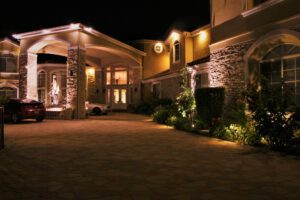Landscape Lighting Installation – Tips For Do-It-Yourselfers
Installing landscape lighting is a weekend project of moderate complexity. However, consulting with a professional for individualized landscape lighting design that meets your goals is important.

Make sure to use fixtures rated for outdoor use and a power source that is GFCI-protected. Calculate your lights’ combined wattage use to determine the type of wiring and transformers you need. Visit https://orlandolandscapelighting.net/ for more information.
Before you install your landscape lighting, determine what features of your home and yard you wish to highlight with light. For example, a fountain, statue, or gazebo may be a focal point, but you can also illuminate walkways and stairs for safety and warmly welcome guests arriving at your front door.
Once you’ve decided on the elements you want to accent, select the fixtures that best match your style and fit within your budget. You can choose between floodlights and spotlights or a combination of both. Floodlights cast a wide beam, ideal for illumination of larger areas such as driveways, while spotlights concentrate a narrower beam to highlight smaller plants and features in your yard.
As you shop for lights, consider color temperature as well. Lights in the same family as the objects you’re lighting will look the most natural, while cooler whites are appropriate for ultramodern designs. If you have a hard time deciding, try picking up a high-powered flashlight and head outdoors at night to see how the fixture looks in context of your landscape.
Once you have a selection of the perfect fixtures for your project, make a sketch of the install location. Be sure to include a diagram of the yard, including your home and any significant outdoor structures or features. Be sure to note any areas that will be difficult to mow or trim around, and take into account whether you’ll need to respect neighbors’ property lines when installing your lights.
Also make a list of the total wattage of all the lights you’ll be using in your system. You’ll need this information when choosing a transformer to power your lighting installation.
Most DIY landscape lighting installations will use low-voltage systems, which are safer and easier to install than 120-volt systems. However, you will still need to have a licensed electrician install the wiring for your landscape lighting.
When selecting your bulbs, make sure they’re rated for exterior use. Although it’s tempting to save a few dollars by purchasing “indoor” bulbs, the finish on these bulbs will not stand up to humidity and changes in temperature. You should also opt for LED lighting whenever possible, as these bulbs consume less energy and last longer than incandescent bulbs. Many LED landscape lights now offer features such as adjustable lumen output, allowing you to control how brightly your space is lit.
Lay Out the Wires
Most landscape lighting designers start with a sketch of the property, marking where each fixture will go. This will allow you to see what your final installation will look like and make rough measurements for estimating cable lengths and connections between fixtures.
After you’ve made your sketches, walk the yard and mark each fixture location with flags or pencils. This will give you an idea of how long the wire runs between each light will be and help you determine if any additional power supplies are necessary.
Low voltage landscape lighting taps into your home’s 120v electrical system and connects to an exterior transformer that steps down the voltage to power landscape lights. This is an option that allows you to add lighting without having to alter or rewire your house’s wiring.
A transformer should be sized to handle all of the light fixtures you’ll be installing at one time. If you want to add more lights later on, or if you have a very large property, consider adding a second transformer to handle the extra load.
If your light installation will be all-wired, bury the wires in a trench 2-6 inches deep, making sure to leave enough length for you to work with at each end of the run. If you’re installing lights on a fence or other hardscape, you can use a fish tape to snake the wires through the material, which will make it easier to conceal.
Once you’ve buried the wires, cover them with mulch or another covering to hide the cable and protect it from weather and tools. Some municipalities have regulations about how deep you must bury the wire, so check your local code before you begin.
If you’re running wires through the ground, a square edge shovel and post hole digger are helpful for digging the trenches needed to bury the cables. You’ll also need a rake and gardening tools for preparing the landscaping before you lay out the wires. For areas where you don’t need to dig a trench, aluminum tent stakes will hold the wire in place. You’ll also need waterproof wire connectors to splice your cables together and protect the connections from water. Finally, a volt meter and tester are essential to monitor the voltage going to each light, as low readings may indicate that you’ve added too many lights to your power supply or need to install a higher tapping on your transformer.
Bury the Wires
Before digging anywhere near buried landscape lighting wires, call your local one number locator service (usually 811). This is a free, statewide toll-free telephone number that allows you to request a locate technician to visit your property before you start digging. Doing so can save you a lot of time, effort and damage to your lawn.
To prevent electrical shock, only use landscape lighting wires that are rated for direct burial. These wires have a thick protective jacket that keeps moisture, fungus and sunlight away from the cable, making them safe to bury underground. You may also wish to supplement your direct burial wiring system with trunking or conduits for added protection.
When you’re ready to bury the wires, dig a trench that’s 2-6 inches deep. Make sure to backfill the trench with the soil that you removed. Pack the dirt in well and smooth it out. You can also fill in any low spots with gravel or crushed stone.
Once the wires are buried, you can finish up your landscaping installation. Begin by checking your work to ensure the light fixtures are plugged in correctly and that they are working properly. If there is glare from the lights, you can correct it by adjusting their positions or reorienting them.
Finally, you can install the transformer for your landscape lighting system. The transformer steps down 120-volt house current to 12 volts, which is the lowest possible voltage for running landscape lighting. You can purchase a low-voltage transformer with built-in photocell and timer or choose to add these components separately.
Connect the landscape lighting wires to the transformer by using the appropriate weatherproof wire connectors. If you have a system with press on connectors, cut the wires and strip 1/2 inch of insulation from each end. Slide the stripped ends under the two terminal screws on the bottom of the transformer and tighten the screws. Connectors can be purchased at most home improvement centers. Be sure to check your work and make any necessary adjustments at night before you reseed the area. This will give you an idea of how the lighting looks and how well your landscape lighting is functioning before you permanently bury the lines.
Test the System
Adding low voltage landscape lighting is a simple way to increase your home’s nighttime curb appeal and safety. This type of exterior lighting is ideal for illuminating walkways, driveways, and garden areas as well as highlighting trees, shrubs, stone walls, fences, and other prominent features in your yard. These landscape lights operate on only 12 volts of electricity and are safe for do-it-yourself installation.
To test your newly installed landscape lights, first make sure the power source for the system is active. Then connect a multimeter’s probes to the positive and negative terminals on the light. If the meter reads within the range specified by the manufacturer, the light is functioning properly.
If the meter reading is far below the recommended range, it may indicate that the light has burned out or that a wire is loose somewhere in the circuit. You can also test the light’s photocell by removing the lens and using your hand to block the sensor. If the light is not turning on, the sensor may be blocked by overgrowth or covered with dirt. If this is the case, clean the sensor to resolve the problem.
Another quick test you can do is to use a digital voltage meter (about $25 at Radio Shack). Connect one end of the meter to the positive terminal on your transformer and the other to the light fixture. Ideally, each halogen light should be receiving 10.5 to 12 volts for a consistent look and to prevent premature burnout.
For safety, never touch any wiring without wearing rubber gloves and using proper eye protection. Before starting any work, call 811 to have the local utility companies mark the location of any underground pipes or lines in your yard. This service is usually free and will help you avoid damaging expensive landscape lighting wires or running into any underground utilities.
If you’re installing a complex landscaping lighting system that connects directly to the power used in your house, you’ll need a professional electrician and will probably require a permit. However, you can easily improve the look and feel of your home with a simpler landscape lighting installation that’s easy for any do-it-yourselfer to manage.

